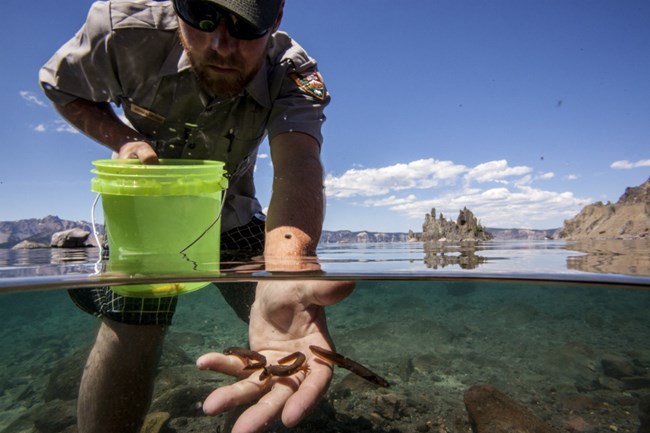Mazama Newt ClassificationSalamaders are amphibians. Newts are salamanders which are semi semiaquatic, living primarily on land but returning to water during reproduction. Mazama newts are a subspecies with notable differences (see below).Kingdom: Animalia
Phylum: Chordata Class: Amphibia Order: Urodela Family: Salamandridae Subfamily: Pleurodelinae Genus: Taricha Species: Taricha granulosa (rough skinned newt) Subspecies:Taricha granulosa mazamae (Mazama Newt) 
photo courtesy of Jeremy Monroe A Distinct PopulationThe following information about rough-skinned and Mazama newts was extracted from The impact of introduced crayfish on a unique population of salamander in Crater Lake, Oregon, written in 2015 by M. W. Buktenica, S. F. Girdner, A. M. Ray, D. K. Hering, and J. Umek. The full document is available from the IRMA DataStore.The Mazama newt (Taricha granulosa mazamae) is a distinct population of the rough-skinned newt (T. granulosa) which is widely distributed throughout the Pacific Northwest, whereas the Mazama sub-species is endemic to Crater Lake. The Mazama newt was first formally described in the 1940s and proposed as a subspecies characterized by unusually dark ventral pigmentation (Myers 1942; Farner and Kezer 1953; fig. 1, page 7). Subsequent genetic analyses of rough-skinned newts confirm that newts in Crater Lake are morphologically, genetically, and physiologically distinct from populations of newts outside of the lake. 
NPS image Toxic or NotThe rough-skinned newt is the only terrestrial animal to contain tetrodotoxin (TTX), the same neurotoxin that is found in deadly saltwater puffer fish (Tetraodontidae) and blue-ringed octopus (Hapalochlaena spp.) Most rough-skinned newts outside the Crater Lake caldera contain measurable levels of TTX and are highly toxic (Brodie 1968). Rough-skinned newts have also evolved bright coloring to warn predators that they are poisonous. Mazama newts have a darker ventral coloration (fig. 1), and extremely low toxicity levels.Prior to the inroduction of non-native fish and crayfish, (1896 to 1941), Mazama newts occupied the key ecological niche as the top aquatic predator. Newts in Crater Lake may be less toxic and darker in color than other populations for multiple reasons. Lower toxicity may be associated with the absence or reduction of a terrestrial life stage and terrestrial predation, the lack of evolutionary history with native aquatic predators, or insufficient energy available to produce toxins in the ultraoligotrophic (i.e., nutrient-poor) lake environment. Darkened coloration on ventral surfaces may also represent a darkening response to elevated ultraviolet radiation (Belden and Blaustein 2002; Garcia et al. 2009), which penetrates to great depth in the exceptionally clear lake (Hargreaves et al. 2007). Aquatic or TerrestrialObservations suggest that the Mazama newt has a more predominantly aquatic life history than typical rough-skinned newts, although terrestrial Mazama newts were reported to be common historically “under the rocks and driftwood along the shore "of Crater Lake (Farner and Kezer 1953).Crayfish: A Pervasive Invasive ThreatSeven species of fish were introduced into Crater Lake beginning around 1896. The purpose for stocking the lake was to create a recreational oportunity, which would elevate public interest, and ultimately gather federal protection. The lake and surrounding forests were designated a national park in 1902 but it wasn't until 1941 that fish were no longer stocked in the lake. Meanwhile, signal crayfish (Pacifastacus leniusculus), a freshwater crustacean, was introduced into Crater Lake around 1915 as food for fish. Henceforth. with only one remaining species of fish that predates on crayfish, the crustacean has survived, thrived, and threatened the existence of Mazama newts.Crayfish distribution has increased from approximately 50% of the shoreline in 2008 to nearly 80% in 2020, while newts have disappeared from most of these same areas. Continued spread of crayfish will likely lead to further declines in newt abundance and distribution, and perhaps elimination. |
Last updated: September 26, 2021
